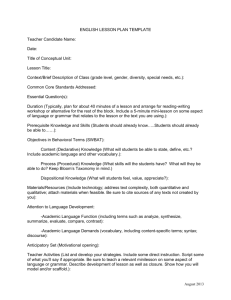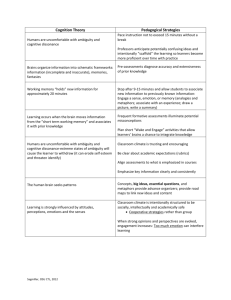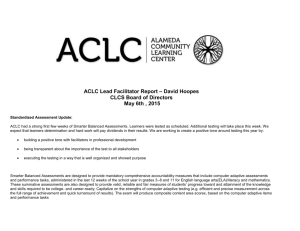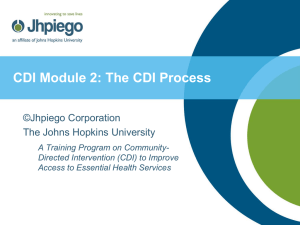A review of Effective Teaching Skills Training
advertisement
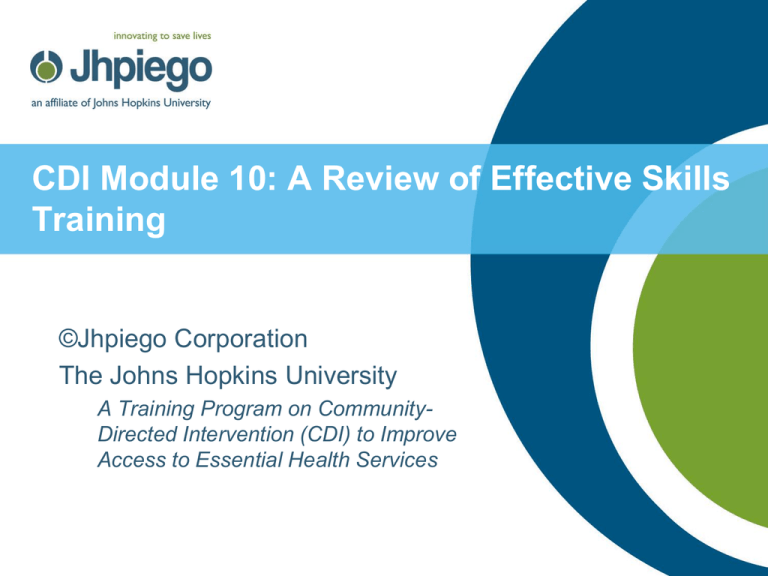
CDI Module 10: A Review of Effective Skills Training ©Jhpiego Corporation The Johns Hopkins University A Training Program on CommunityDirected Intervention (CDI) to Improve Access to Essential Health Services Module 10 Objectives By the end of this module, learners will: List principles and approaches of adult education for training health workers Describe a conducive learning environment that enables active skills practice and learning Identify locally appropriate learning aids Provide examples of training methods and experiences that are interactive Explain the need to monitor, evaluate and revise training 2 Time Is Needed for Practice This module presents the 12 effective teaching skills quickly Facilitators should plan practical opportunities for learners (e.g., community-directed intervention [CDI] focal persons) to develop sample communitydirected distributor (CDD) learning sessions based on these modules 3 The Components of Effective Training 1. Lay the foundations for educating health care providers 2. Develop objectives for learning 3. Plan for teaching 4. Prepare the learning environment 5. Prepare and use teaching aids 6. Prepare and deliver interactive presentations 7. Facilitate group learning 8. Monitor and revise teaching 9. Facilitate the development of health care delivery skills 10. Manage clinical practice 11. Prepare and use knowledge assessments 12. Prepare and use skills assessments 4 1. Lay the Foundations for Educating Health Care Providers Lay strong foundations by: • Describing the guiding principles of adult education for training health care providers • Defining core tasks and competencies and their role in curriculum development and design • Recognizing effective approaches to teaching and learning • Listing the challenges in educating health care providers Adults learn best when they can share what they already know and learn more by actively doing 5 2. Develop Objectives for Learning Focus your training by: Identifying the knowledge, skills and attitudes to be learned in your course Writing measurable, observable objectives Writing supporting objectives Sample By the end of this session, the CDD will: Determine whether a child has fever Administer and interpret a rapid diagnostic test (RDT) Provide age-appropriate artemisinin-based combination therapy (ACT) for malaria Counsel a caregiver on the need for taking a full course of ACT Ask a caregiver to report back if child does not improve 6 3. Plan for Teaching Develop a course syllabus Plan for learner assessment Select teaching methods Select and adapt learning materials Develop a course schedule 7 4. Prepare the Learning Environment Set up a space for learners that provides: Comfort Ease of interaction Opportunities for simulation or practice Adequate equipment and supplies 8 5. Prepare and Use Teaching Aids Examples include: Using a writing board Employing a flip chart Preparing and using slides Using video Developing culturally appropriate stories, proverbs and songs 9 Use Locally Available Materials 10 6. Prepare and Deliver Interactive Presentations Plan a presentation Introduce a presentation Use effective presentation skills Use questioning techniques during a presentation Summarize a presentation 11 7. Facilitate Group Learning Select, plan and facilitate group learning activities Create and facilitate a role play Create and facilitate a case study Create and facilitate a clinical simulation Facilitate a brainstorming session Facilitate a discussion 12 8. Monitor and Revise Instruction Ensure that observers take notes at each session Establish ways for learner feedback Hold facilitators’ meetings to review and revise teaching 13 9. Facilitate the Development of Health Care Delivery Skills List the steps of skills development Develop and use competency-based learning tools Introduce and demonstrate a skill Facilitate skills practice and give feedback 14 10. Manage Clinical Practice Select and prepare clinical instructors and staff Coordinate clinical practice Conduct clinical practice sessions Monitor learners’ progress CDDs need guided opportunities to learn correct community case management procedures 15 11. Prepare and Use Knowledge Assessments Select methods for assessing learners’ knowledge Prepare knowledge assessments Develop questions for objective, written examinations Administer and score knowledge assessments Use assessment results to improve performance Design formats for low-literacy learners 16 12. Prepare and Use Skills Assessments Select methods for assessing learners’ skills Prepare skills assessments Develop structured practical examinations Administer and score skills assessments Use results to improve performance 17 Summary Training health care workers—including CDDs— should be based on principles and approaches of adult education The learning environment should be conducive to learning and enable active skills practice Locally appropriate learning aids should be developed and used Training methods and experiences should be interactive Training should be monitored, evaluated and revised 18
